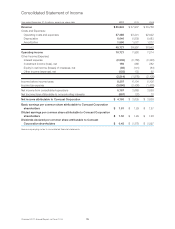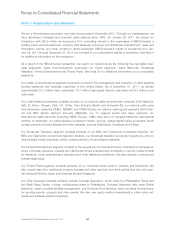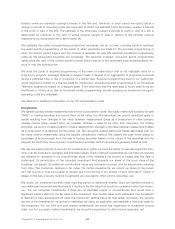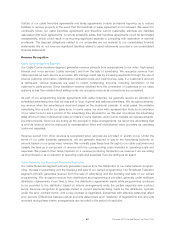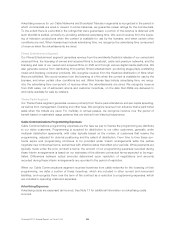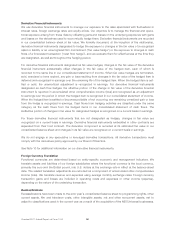Comcast 2011 Annual Report Download - page 90
Download and view the complete annual report
Please find page 90 of the 2011 Comcast annual report below. You can navigate through the pages in the report by either clicking on the pages listed below, or by using the keyword search tool below to find specific information within the annual report.Advertising revenue for our Cable Networks and Broadcast Television segments is recognized in the period in
which commercials are aired or viewed. In some instances, we guarantee viewer ratings for the commercials.
To the extent there is a shortfall in the ratings that were guaranteed, a portion of the revenue is deferred until
such shortfall is settled, primarily by providing additional advertising time. We record revenue from the licens-
ing of television productions when the content is available for use by the licensee, and when certain other
conditions are met. When license fees include advertising time, we recognize the advertising time component
of revenue when the advertisements are aired.
Filmed Entertainment Segment
Our Filmed Entertainment segment generates revenue from the worldwide theatrical release of our owned and
acquired films, the licensing of owned and acquired films to broadcast, cable and premium networks, and the
licensing and sale of our owned and acquired films on DVD and through various digital media platforms. We
also generate revenue from distributing third parties’ filmed entertainment, producing stage plays, publishing
music and licensing consumer products. We recognize revenue from the theatrical distribution of films when
films are exhibited. We record revenue from the licensing of a film when the content is available for use by the
licensee, and when certain other conditions are met. When license fees include advertising time, we recog-
nize the advertising time component of revenue when the advertisements are aired. We recognize revenue
from DVD sales, net of estimated returns and customer incentives, on the date that DVDs are delivered to
and made available for sale by retailers.
Theme Parks Segment
Our Theme Parks segment generates revenue primarily from theme park attendance and per capita spending,
as well as from management, licensing and other fees. We recognize revenue from advance theme park ticket
sales when the tickets are used. For multiday or annual passes, we recognize revenue over the period of
benefit based on estimated usage patterns that are derived from historical experience.
Cable Communications Programming Expenses
Cable Communications programming expenses are the fees we pay to license the programming we distribute
to our video customers. Programming is acquired for distribution to our video customers, generally under
multiyear distribution agreements, with rates typically based on the number of customers that receive the
programming, adjusted for channel positioning and the extent of distribution. From time to time these con-
tracts expire and programming continues to be provided under interim arrangements while the parties
negotiate new contractual terms, sometimes with effective dates that affect prior periods. While payments are
typically made under the prior contract’s terms, the amount of our programming expenses recorded during
these interim arrangements is based on our estimates of the ultimate contractual terms expected to be nego-
tiated. Differences between actual amounts determined upon resolution of negotiations and amounts
recorded during these interim arrangements are recorded in the period of resolution.
When our Cable Communications segment receives incentives from cable networks for the licensing of their
programming, we defer a portion of these incentives, which are included in other current and noncurrent
liabilities, and recognize them over the term of the contract as a reduction to programming expenses, which
are included in operating costs and expenses.
Advertising Expenses
Advertisingcostsareexpensedasincurred.SeeNote17 for additional information on advertising costs
incurred.
Comcast 2011 Annual Report on Form 10-K 88


